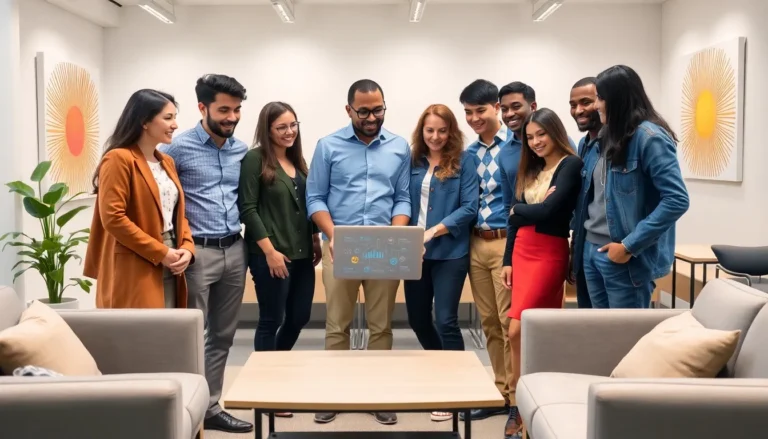In a world where instant gratification reigns supreme, thinking long-term can feel like trying to find a needle in a haystack. Yet, embracing a time horizon vision isn’t just a fancy term for procrastination; it’s the secret sauce that separates the dreamers from the doers. Imagine planting a tree today that’ll provide shade for generations to come. Sounds poetic, right? But it’s also a powerful strategy for achieving sustainable success.
Table of Contents
ToggleOverview of Time Horizon Vision
Time horizon vision encompasses a strategic approach focused on long-term objectives. This concept highlights the importance of looking beyond immediate results to ensure sustainable growth. Society’s tendency towards instant gratification often clouds judgment, making it essential to keep the broader perspective in mind.
Strategic thinking plays a pivotal role in cultivating a time horizon vision. By evaluating various scenarios, individuals and organizations can identify potential pathways for success. A crucial aspect of this vision involves recognizing the long-term implications of decisions made today. Short-term fixes may yield temporary relief, but they often neglect future consequences.
Rooted in foresight, time horizon vision encourages investment in robust foundations. Those who prioritize long-term planning position themselves better for resilience in the face of challenges. Actions taken today should align with future aspirations, creating a roadmap for achievement. The metaphor of planting a tree serves as a reminder that present efforts can yield future benefits.
Real-world examples illustrate the impact of time horizon vision. Companies that adopt this perspective tend to innovate more effectively and adapt to market changes. Leaders focused on long-term goals often inspire their teams to maintain commitment and motivation. In sectors like technology and healthcare, patience and persistence yield groundbreaking advancements.
Emphasizing the significance of this vision ultimately fosters an environment that values growth and stability. Achieving lasting success relies heavily on making decisions with a future perspective in mind. Balancing immediate needs with long-term objectives defines a comprehensive strategy essential for sustainable progress.
Importance of Time Horizon Vision

Time horizon vision plays a critical role in shaping future success. Emphasizing long-term planning over short-term gains supports sustainable growth.
Short-Term vs. Long-Term Thinking
Individuals often face the choice between short-term solutions and long-term objectives. Short-term thinking yields quick fixes but can lead to unforeseen repercussions. Long-term thinking fosters deeper insights, paving the way for strategic investments. Examples show that businesses prioritizing long-term goals frequently experience greater innovation and market adaptability. Balancing both perspectives enhances decision-making, allowing for careful assessment of immediate actions alongside future implications. Ultimately, embracing long-term thinking cultivates a culture of resilience and steady progress.
Impact on Decision Making
Decision-making processes significantly benefit from a time horizon vision. When leaders consider the long-term outcomes of their choices, they act with a greater sense of responsibility. Evaluating options through this lens reveals potential consequences that short-term-focused decisions may overlook. Organizations prioritizing long-term strategies often position themselves better to weather economic fluctuations. Recognizing the long-term impact encourages a strategic approach to resource allocation, ensuring that investments generate value over time. By adopting this vision, teams foster commitment and motivation, propelling themselves toward innovative solutions and sustained growth.
Components of Time Horizon Vision
Time horizon vision comprises several critical components that inform long-term strategies, including strategic planning and goal setting. These elements work together to create a robust framework for achieving sustainable success.
Strategic Planning
Strategic planning forms the backbone of time horizon vision. It involves defining the long-term objectives that guide decision-making. Organizations analyze current resources and identify potential challenges while forecasting future trends. This proactive approach is essential for anticipating changes in market dynamics. Effective strategic planning encompasses scenario analysis, allowing teams to evaluate various outcomes based on differing assumptions. Companies that engage in comprehensive planning demonstrate resilience, adapting to shifting environments more efficiently. Adopting a flexible mindset fosters innovation, enabling organizations to pivot when necessary while keeping long-term goals in sight.
Goal Setting
Goal setting establishes clear benchmarks within the time horizon vision framework. Defining specific, measurable, achievable, relevant, and time-bound (SMART) goals provides direction and clarity. Long-term objectives stem from a thorough understanding of both aspirations and available resources. Ensuring alignment between individual and organizational goals creates unity and reinforces commitment. Regularly reviewing progress helps maintain focus, enabling timely adjustments to strategies and plans. A strong emphasis on goal setting encourages team collaboration and motivates individuals to contribute to overarching aims. Organizations that prioritize goal setting inspire their workforce, cultivating a culture of continuous improvement and growth.
Challenges in Maintaining Time Horizon Vision
Maintaining a time horizon vision presents various challenges that can hinder effective long-term planning. Recognizing these pitfalls is essential to develop strategies that promote resilience.
Common Pitfalls
Organizations often fall into several common pitfalls. Focusing solely on short-term gains detracts from long-term objectives. Leaders may struggle to align team goals with overarching vision, leading to a lack of motivation. In addition, insufficient communication about long-term strategies can create confusion and disengagement among team members. A failure to adapt to market changes can further exacerbate these issues. Lastly, ignoring data-driven insights when making decisions may result in missed opportunities that could otherwise support sustainable growth.
Overcoming Obstacles
Overcoming these obstacles starts with fostering a culture of long-term thinking. Prioritizing transparent communication keeps teams informed and engaged. Setting regular check-ins on progress towards long-term goals encourages accountability. Utilizing data analytics aids in making informed decisions that align with strategic objectives. Additionally, investing in employee training on long-term thinking enhances team capabilities. Emphasizing flexibility within strategic plans allows organizations to adapt to unforeseen challenges. Ultimately, developing a comprehensive strategy that balances immediate needs with future aspirations is crucial for success.
Case Studies on Time Horizon Vision
Several case studies illustrate the effectiveness of time horizon vision in diverse sectors. Companies that adopt long-term perspectives frequently outperform their competitors. For example, tech giants like Apple prioritize research and development, ensuring that innovative products meet future consumer demands. Their commitment to long-term goals results in sustained market leadership.
Another example includes healthcare organizations focusing on patient outcomes instead of short-term profits. These entities invest in preventive care and longitudinal studies, fostering better overall health for communities while improving their reputation and profitability over time. Results show that such investments lead to increased patient loyalty and enhanced service quality.
Retail giants like Costco exemplify time horizon vision through their employee-centric strategies. They prioritize customer satisfaction and employee retention over quick financial gains. This long-term focus generates a committed workforce and loyal customer base, leading to steady revenue growth.
In the automotive industry, Tesla embodies time horizon vision by investing heavily in sustainable technology. Their dedication to electric vehicles and renewable energy solutions illustrates how looking ahead fosters industry innovation. Analysts predict that such foresight positions Tesla as a major player in the future automotive market.
Finally, Unilever’s commitment to sustainable sourcing reflects the importance of time horizon vision in supply chain management. By prioritizing environmentally friendly practices, Unilever improves its brand image while securing a reliable resource supply. This approach enhances resilience against market fluctuations and strengthens customer trust.
These case studies demonstrate how organizations that truly embrace time horizon vision can navigate complexities effectively while reaping long-term benefits.
Embracing a time horizon vision is essential for anyone aiming for sustainable success. By prioritizing long-term objectives over short-term gains, individuals and organizations can build a robust foundation that withstands future challenges. This approach not only fosters innovation but also encourages resilience in an ever-changing landscape.
Investing in strategic planning and goal setting creates a culture of commitment and collaboration. Leaders who champion this vision inspire their teams to stay focused on the bigger picture. As demonstrated by successful companies across various sectors, a long-term perspective leads to better decision-making and lasting value.
Ultimately, the journey toward achieving long-term goals requires patience and adaptability. Those who cultivate a time horizon vision position themselves to thrive in the face of uncertainty while paving the way for future generations.









